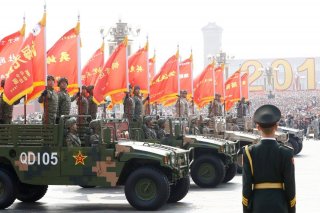Pearl Harbor, 2020 Edition: Could China Beat the U.S. Military in a Surprise Attack?
U.S. forces are more vulnerable than you think.
Key Point: Forward-deployed U.S. forces in Japan and Guam would be a key target.
The U.S. military must find ways of defeating any attempt by China to launch surprise strikes using non-nuclear weapons, analyst Sam Goldsmith argued in a new article for Naval War College Review.
“China likely would aim to confine itself to the use of conventional weapons during any potential high-intensity conflict with the United States—particularly given that China already possesses a lethal array of long-range, conventional, theater-strike options,” Goldsmith wrote in “U.S. Conventional Access Strategy: Denying China a Conventional First-Strike Capability.”
“Such a strategic, conventional, first-strike option is one that the United States should seek to deny China by developing an effective conventional access strategy.”
In the event of war with the United States over disputed Pacific territories, Chinese forces likely would attempt to neutralize forward-deployed U.S. forces in Japan and Guam and at sea, Goldsmith explained.
Next, the People’s Liberation Army would attack U.S. reinforcements heading west to the Pacific theater, Goldsmith added.
In carrying out this strategy, the PLA will employ each of its four subordinate service branches: the PLA Army, the PLA Navy (PLAN), the PLA Air Force (PLAAF), and the PLA Rocket Force (PLARF). PLAN submarines would execute undersea attacks against U.S. ships and submarines in port or at sea and strike at land targets with cruise missiles.
The PLAAF would execute air strikes against U.S. aircraft on the ground or in the air, as well as U.S. ships and submarines in port or at sea. Strikes against U.S. bases would occur with extended-range missiles launched from PLAAF combat aircraft or conventional ballistic missiles launched from the Chinese mainland.
“The U.S. military should consider introducing a conventional access strategy, designed specifically to balance the PLA’s counterintervention strategy,” Goldsmith proposed. “The purpose would be to provide the U.S. military with an improved capacity to deter a PLA conventional first strike, and, if necessary, degrade PLA capabilities with long-range conventional strike forces, to facilitate access for follow-on U.S. forces.”
A U.S. conventional access strategy would require four distinct capabilities. A theater-wide passive-defense capability would enhance the ability of forward-deployed U.S. forces to survive initial PLA conventional strikes.
A conventional theater-strike capability would enable the U.S. military to begin degrading PLA capabilities immediately at the outset of a conflict, without access to in-flight refueling tankers or usable runways.
A theater-recovery capability would restore basic runway access in the aftermath of PLA conventional strikes.
A rapid-response capability would allow long-range [U.S. Air Force] bombers and fighter escorts to deploy rapidly to U.S. bases in the western Pacific, capitalizing on freshly repaired runways as well as prepositioned stocks of aviation fuel and conventional earth-penetrating ordnance.
Consider Goldsmith’s proposal in light of a related plan that the Washington, D.C. Center for Strategic and Budgetary Assessments published in May 2019.
To blunt China’s advantage, CSBA analysts recommended the Pentagon pursue “a military strategy of maritime pressure, which includes a new inside-out defense operational concept.”
“The strategy of maritime pressure aims to persuade Chinese leaders that attempting military aggression in the Western Pacific will fail, thus discouraging them from trying it,” CSBA explained.
Some troops -- in particular, U.S. Army and Marine forces with mobile rocket launchers, supported by a few U.S. Navy ships and small contingents of U.S. Air Force warplanes -- would hunker down on and around islands near China, preparing to hit Chinese troops from inside China’s own expanding lines.
These “inside” forces would help poke holes in Chinese defenses that could help follow-on forces reach the combat zone.
It would be risky. “Implementing this inside-out defense concept will require some U.S. forces to operate and survive within range of Chinese missiles,” the analysts noted.
Goldsmith’s own proposal posits one approach to ensuring those inside forces can blunt and survive the initial Chinese onslaught and then receive reinforcements. Land-based rockets, rapid-repair capabilities and concepts for quickly deploying aerial reinforcements could help U.S. forces to recover from, and reverse, surprise Chinese advances.
David Axe served as defense editor of the National Interest. He is the author of the graphic novels War Fix, War Is Boring and Machete Squad. This article first appeared in 2019.
Image: Reuters

